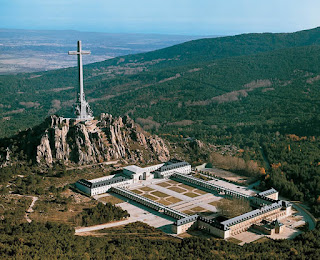Mausoleum (pronounced maw-suh-lee-uhm or maw-zuh-lee-uhm)
(1) A
stately and magnificent tomb or a building containing tombs (a burial place for
the bodies or remains of many individuals, often of a single family, usually in
the form of a small building).
(2) In
casual use, a large, gloomy, depressing building, room, or the like.
(3) As
one of the Seven Wonders of the Ancient World, the tomb erected at
Halicarnassus in Asia Minor in circa 353 BC.
1375–1425:
From the late Middle English mausoleum,
from the Latin mausōlēum, from the Ancient
Greek Μαυσωλεῖον (Mausōleîon), from Μαύσωλος (Maúsōlos) (the tomb of satrap of the
Persian empire and ruler of Caria, built at Halicarnassus in Asia Minor in circa
353 BC and one of the Seven Wonders of the Ancient World). The general use to describe "any stately
burial-place" (now usually one designed to contain a number of tombs) is
from circa 1600. Synonyms include burial
vault, cemetery, coffin, monument, crypt, sepulcher, catacomb & grave. Mausoleum is a noun and mausolean is the adjective;
the noun plural forms are mausoleums or mausolea, the former now most
prevalent. Although “tomb” is now more
common, mausoleum has long been used to refer to any large, above-ground tomb.
The Μαυσωλεῖον τῆς Ἁλικαρνασσοῦ (Mausoleum
at Halicarnassus) was one of the Seven Wonders of the Ancient World. Built between 353-350 BC in Halicarnassus on
the coast of Asia Minor (modern-day Turkey), it was destroyed by a number of earthquakes
from the twelfth to fifteenth century; when finally if fell, of the seven wonders from Antiquity, only the pyramids
at Giza remained. The name Mausolus translates as “much
blessed” and his wife Artemisia II of Caria was also his sister, something far
from unknown at the time. Nominally a
satrap of the Achaemenid Empire, Mausolus was the ruler of Caria between
377–353 BC) having inherited the throne from his father Hecatomnus who became
king after assassinating the previous Satrap Tissaphernes, something also far
from unknown at the time and since.
Something of a Valhalla of the south and for decades the last resting place of forty-thousand-odd dead from both sides in the Spanish Civil War (1936-1939), the most controversial corpse in the place was that of Franco himself although obviously, he was not a battlefield casualty. There were those who on that basis objected but, because the mausoleum was also a basilica, under the rules of the Roman Catholic Church, he was ruled entitled to a place because of his role in “building the church”, a double irony being the Caudillo himself specified he be buried elsewhere. Franco’s body originally was interred in a granite and marble crypt beneath the basilica's floor and the government's decision to permit that ensured ensured the site would both become a shrine for those who venerate his memory and an ongoing controversy because the bitter disputes about the war and Franco’s subsequent dictatorship were only ever suppressed; in the decades after his death the political and legal manoeuvres to remove from public display all the many relics of the glorification of the victory and dictatorship gathered strength. In October 2019, his remains were exhumed from the mausoleum and re-interred in the Mingorrubio Cemetery in El Pardo, this time in a family crypt, an event which much divided opinion. The forces unleashed by the civil war and its decades-long aftermath remain a cleavage in Spanish society and political scientists expect the tensions to continue, even after the war passes from living memory. In his last public speech a few weeks before his death, Franco had warned the country it remained threatened by a conspiracy involving “communists, left-wing terrorists and Freemasons”.
Adolf Hitler (1889-1945; Führer (leader) and German head of government 1933-1945 & head of state 1934-1945)
made only one visit to Paris, less as a victorious warlord and more as a
tourist looking at the architectural highlights. From years of somewhat haphazard study, Hitler
was well acquainted with the buildings of the city and genuinely knowledgeable about
details such as the interior fittings of the Paris Opera House but told his
architect: “The moment in Paris where I
saluted Napoleon's tomb was one of the proudest of my life.” Hitler had always intended a mausoleum for
himself in Linz, the centrepiece of which would be a Napoleonic sarcophagus in
the centre of a Pantheon-like structure with an oculus directly above, exposed
to the elements and thus “directly linked
to the universe." He made a
number of sketches, all predictably in the classical style and distinguished
mostly by their massive dimensions.
There
is an urban myth the chamber in which Napoleon's sarcophagus is placed was designed in such as way that if seen
from the lower lever, the viewer must look-up as if in awe and if seen from
above, one must bow. However, Les Invalides was completed in 1706 and
the two levels of the chapel were included so the king might attend Mass with his
soldiers; the lower level for soldiers & patients, the upper for the royal
court. Only in 1861 was the chapel converted
to a mausoleum after Napoleon’s body was returned by the British, almost half a
century after his death.



No comments:
Post a Comment